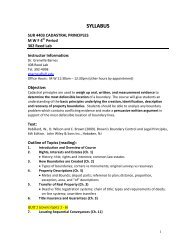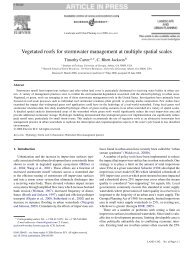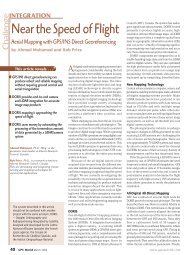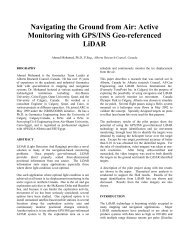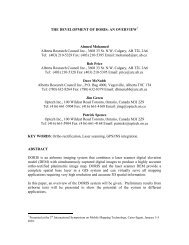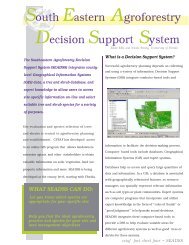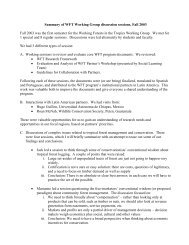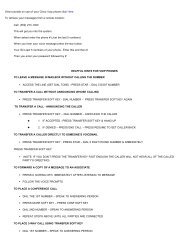Goats Among Trees: A Silvopastoral Possibility - University of Florida
Goats Among Trees: A Silvopastoral Possibility - University of Florida
Goats Among Trees: A Silvopastoral Possibility - University of Florida
You also want an ePaper? Increase the reach of your titles
YUMPU automatically turns print PDFs into web optimized ePapers that Google loves.
<strong>Goats</strong> among <strong>Trees</strong>:<br />
A <strong>Silvopastoral</strong> <strong>Possibility</strong><br />
Onokpise, O.U., A. McKenzie-Jakes, L. Whilby, <strong>Florida</strong> A&M <strong>University</strong>,<br />
Strong, N. <strong>University</strong> <strong>of</strong> <strong>Florida</strong>, Center for Subtropical Agr<strong>of</strong>orestry<br />
There is an opportunity for<br />
many small farmers to utilize<br />
either existing stands <strong>of</strong> trees<br />
(both natural and plantations) or<br />
abandoned pastures to produce<br />
goats, timber and forage,<br />
all in the same system.<br />
A growing demand for<br />
goat products can make<br />
this a pr<strong>of</strong>itable addition<br />
to your enterprise.<br />
This fact sheet was<br />
published by the Center<br />
for Subtropical<br />
Agr<strong>of</strong>orestry to introduce<br />
rationale, benefits, and<br />
challenges to managing<br />
goats in Silvopastures.<br />
Resources are provided<br />
at the end to guide your<br />
further exploration <strong>of</strong> this<br />
topic.<br />
Introduction<br />
As with any product or commodity,<br />
annual timber or cattle prices can<br />
vary greatly.<br />
In a world <strong>of</strong> fluctuating markets,<br />
diversifying your income sources<br />
and keeping inputs to a minimum<br />
can reduce risk and improve the<br />
overall productivity <strong>of</strong> your farm and<br />
forest land.<br />
People are increasingly finding<br />
Silvopasture a preferred way to<br />
accomplish this.<br />
By combining livestock with<br />
timber production and forage<br />
management, landowners can<br />
procure an annual income from<br />
livestock while waiting for timber to<br />
Come visit us in Quincy!<br />
Kids born this Spring will be placed in FAMU<br />
trial silvopasture sites.<br />
mature, reduce the amount <strong>of</strong> inputs<br />
they have to provide ( fertilizers,<br />
herbicides, and feed) and reap the<br />
benefits <strong>of</strong> productivity in all three<br />
components (livestock, timber, and<br />
forage).<br />
Silvopasture is established by<br />
planting trees on existing pasture, or<br />
by thinning existing stands and<br />
managing for optimal forage.<br />
In southern Alabama and Northern<br />
<strong>Florida</strong>, landowners have focused on<br />
utilizing cattle in their silvopasture<br />
operations, <strong>of</strong>ten neglecting other<br />
pr<strong>of</strong>itable livestock species, including<br />
meat, dairy, and fiber goats.<br />
Why <strong>Goats</strong> and <strong>Trees</strong>?<br />
1. A Growing Goat Market<br />
As Caribbean, Muslim, and other<br />
ethnic populations grow in the US, so<br />
does consumption <strong>of</strong> traditional goat<br />
meat, milk, and cheese products. It<br />
is estimated that goat meat demand<br />
in the United States is currently twice<br />
domestic production. That translates<br />
to earning potential!<br />
<strong>Goats</strong> are hearty animals, and<br />
can be managed on limited<br />
acreage. Small-scale, or parttime<br />
farmers can usually achieve<br />
self-sufficiency with a relatively<br />
small herd.<br />
Fencing and herd health<br />
managment will be the largest<br />
and most important investments<br />
you make. To get a good return,<br />
you need to ensure protection<br />
from predators and monitor<br />
parasite loads and diseases.<br />
2. Synergy<br />
By combining trees with forage<br />
and livestock, you reduce<br />
moisture loss that occurs in an<br />
open pasture, provide shade<br />
and protection for your goats,<br />
and improve soil conditions for<br />
tree and forage growth.<br />
3. <strong>Goats</strong> as “Herbicides”<br />
<strong>Goats</strong> forage differently than most<br />
small ruminants. If given a choice,<br />
they prefer to forage the top <strong>of</strong> a<br />
plant or shrub and work their way<br />
down.<br />
Not only do goats perform better on a<br />
diverse diet, but they also control<br />
vegetation that would otherwise<br />
compete with your trees for nutrients<br />
and water.<br />
Holiday Dates Type <strong>of</strong> Goat in Demand<br />
Western and Eastern Easter March/April kids < 1 yr.<br />
Navadurgara/Dashara October Male adult goats<br />
Start/End <strong>of</strong> Ramadan Oct.-Dec. Kids w/ milk teeth<br />
Id al Adha Feb.-March Yearlings<br />
Also Important: Christmas, July 4, Jamaican Independance Day, and Carnival<br />
CSTAF Fact Sheet 6
Current Research<br />
In an attempt to assist small farmers<br />
in the Southeastern United States<br />
make management decisions<br />
regarding goat silvopasture systems,<br />
researchers at <strong>Florida</strong> A&M<br />
<strong>University</strong> have been conducting<br />
studies on established research and<br />
demonstration sites throughout the<br />
<strong>Florida</strong> panhandle.<br />
Currently in its initial stages, this<br />
research is being undertaken with<br />
the goal <strong>of</strong> providing information on<br />
optimal goat stocking rates, tree<br />
spacing configurations, forage<br />
production and other management<br />
variables.<br />
Preliminary Results<br />
Goat Stocking Rates<br />
Early studies show that stocking<br />
rates may affect goat weight gain.<br />
Of course, a lot <strong>of</strong> this has to do with<br />
the quality <strong>of</strong> forage that is provided,<br />
but producers will need to ensure<br />
that they do not over-stock their<br />
silvopasture cells. Good rotation<br />
practices not only improves weight<br />
gain, but will reduce parasite loads<br />
as well.<br />
<strong>Goats</strong> were stocked at rates <strong>of</strong> 8, 12,<br />
and 16 goats per acre. A stocking<br />
rate <strong>of</strong> 12 goats / acre showed<br />
maximal gain for the goats without<br />
compromising forage production.<br />
Where goats were stocked at higher<br />
rates, forage production was<br />
reduced. Tree growth, however, was<br />
not affected by goat stocking rate.<br />
Soil Quality<br />
Experiments have been conducted<br />
that compare soil pH, moisture<br />
content, and organic matter content<br />
<strong>of</strong> soil in open pastures and in<br />
silvopasture systems. Results<br />
indicate that silvopasture systems<br />
might improve soil quality by<br />
providing shade, increasing moisture<br />
content, and providing temperature<br />
moderation. The extent to which this<br />
will occur will vary on the specific<br />
site conditions and tree spacing.<br />
Tree Spacing and Growth<br />
<strong>Trees</strong> were thinned from an original<br />
4’ x 8’ stand to a spacing <strong>of</strong> 4’ x 40’.<br />
Bahia and bermuda grass were<br />
seeded for forage underneath.<br />
<strong>Trees</strong> responded to thinning and<br />
CSTAF Fact Sheet 6<br />
spacing with a 20% increase in<br />
diameter growth.<br />
Pasture Performance<br />
<strong>Among</strong> the varieties <strong>of</strong> forage<br />
evaluated to date, Tifton bahiagrass<br />
has shown superior establishment<br />
and productivity in the goat<br />
silvopasture system.<br />
None <strong>of</strong> the results at this point are<br />
conclusive and will need to be<br />
replicated over time before any final<br />
statements can be made.<br />
GET INVOLVED!<br />
If you would like to work with<br />
CSTAF to establish a goat<br />
silvopasture trial on your land,<br />
please contact us:<br />
(352)846-3496, or:<br />
http://cstaf.ifas.ufl.edu<br />
Additional Considerations<br />
Which Goat Breed?<br />
There are several breeds available in<br />
the US that are suitable to the<br />
Southeast. <strong>Goats</strong> commonly raised<br />
for meat production include the Boer,<br />
Kiko, Spanish, and the Texas<br />
Genemaster. Production traits that<br />
should be considered when selecting<br />
breeding stock for meat goats are:<br />
Adaptability: Animals should be<br />
adapted to the same environmental<br />
conditions <strong>of</strong> your farm.<br />
Growth Rate: Select animals with<br />
highest post-weaning growth rates.<br />
Reproduction: Purchase or retain<br />
does that produce twins.<br />
Feed Efficiency: Select animals that<br />
require least feed to gain weight.<br />
For more information on goat breeds<br />
and characteristics, contact Angela<br />
Jakes at (850) 875-8556.<br />
Where Do I Start?<br />
It is beyond the scope <strong>of</strong> this article<br />
to discuss specific animal<br />
husbandry, forage, or tree<br />
management practices. Contact<br />
your local county extension <strong>of</strong>fice,<br />
neighboring goat producers, or one<br />
<strong>of</strong> the listed contacts included on this<br />
sheet.<br />
For More Information:<br />
Websites<br />
FAMU Statewide Goat Program:<br />
http://www.famu.edu/acad/cesta/coopgoat-articles.htm<br />
The Goat Farmer.<br />
http://www.caprine.co.nz<br />
Clemson <strong>University</strong><br />
http://www.clemson.edu/agronomy/<br />
goats.index.html.<br />
ATTRA ~Appropriate Technology<br />
Transfer for Rural Areas.<br />
http://attra.ncat.org/attra-pub/<br />
meatgoat.html<br />
listserv <strong>of</strong> producers<br />
http://www.cybergoat.com<br />
High goat demand holidays<br />
http://www.interfaithcalendar<br />
.org/2001.htm<br />
Literature<br />
The GoatKeeper’s Veterinary Book.<br />
Third Edition, Farming Press, Ipswich,<br />
U.K. ISBN 0-309-03185-0.<br />
Meat <strong>Goats</strong>. A booklet about the<br />
basics <strong>of</strong> meat goat production.<br />
Alberta Goat Breeders Association.<br />
($15.00)<br />
Meat Goat Monthly News. Ranch<br />
Publishing, the American Meat Goat<br />
Association. PO Box 2678, San<br />
Angelo, TX 76902. (915) 655-4434.<br />
Regional<br />
Alabama<br />
Alabama A&M <strong>University</strong><br />
Robert Spencer<br />
Small Farms Outreach Program<br />
(256) 372 4958<br />
rspencer@aamu.edu<br />
Georgia<br />
GA Goat Research & Extension Center<br />
Fort Valley College<br />
Dr. Govind Kannann<br />
(478) 825-6816<br />
<strong>Florida</strong><br />
<strong>Florida</strong> A&M <strong>University</strong><br />
Ms. Angela McKenzie-Jakes<br />
(850) 875 - 8555<br />
Mr. Godfrey Nurse<br />
(850) 875 - 8556



